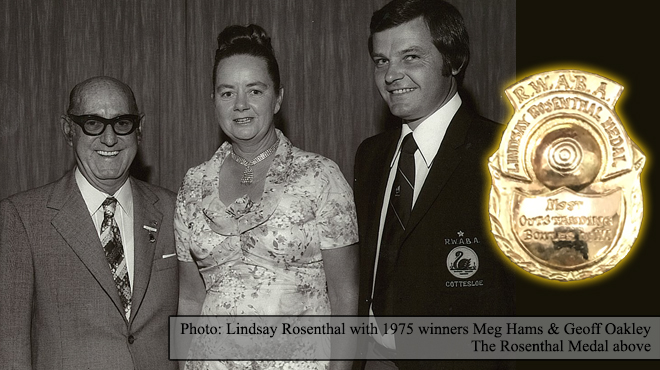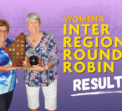From the archives – The Rosenthal Medal
About the Man and the Medal It was 1943 when Lindsay Kenneth Rosenthal arrived in WA from South Australia with a bank roll of $300 and another $200 borrowed from his father.
He started a small jewellery store in Murray Street, which became the corner stone for Australia’s third biggest jewellery chain.
Lindsay Rosenthal was born in Adelaide in 1917. He was the second son of Mick and Golda Rosenthal and the family lived in Renmark, where his father conducted Rosenthal Motors.
In his youth Lindsay was involved in an accident when he was run over by a car, which left him with two cracked vertebrae.
He was educated at Renmark High School and was inducted into Adelaide University, where he completed one year of a Business Management Degree specialising in Accountancy.
When war broke out he quit Uni and joined the army. He eventually was sent to the Middle East. While in Egypt he suffered severe spinal injury, which forced him out of the Army.
On returning to Australia he was discharged and decided to make a start at re-building his life in Perth. There he saw the girl who was to become his wife.
She was Naomi Edelmann and they met at a dance held at Princess Hall, adjacent to the School in Brisbane Street, Highgate. They were married in 1944 and lived with Mr Edelman and his daughter Leah at 21 Regent Street, Mt Lawley.
The couple had two children John who was born in 1945 and Peter who was born in 1950.
Lindsay Rosenthal built his small jewellery shop into a big chain which comprised Lindsay’s the Jewellers, Caris Bros, Saunders the Jewellers and Rosenthal Jewellery Corporation. He also went, in a big way, into searching for gemstones throughout WA.
He achieved this in a little over 30 years.
It was only a quirk of fate that prevented Lindsay Rosenthal from being in control of the biggest chain of jewellery stores in Australia.
He had assembled, with merchant bank help, the “necessary Millions” to make the takeover bid for the chain in 1975.
Only a last minute change of heart by the then owner grabbed the mantle from Mr Rosenthal’s grasp.
Mr Rosenthal’s interests were so diversified that most people did not relate the man himself to the project’s he initiated.
His last big venture was Rosenthal Duty-Free, which competed with Hong Kong and Singapore for the traveller’s dollar. His youngest son Peter was Managing Director of the new business.
Lindsay Rosenthal’s other interests included horse racing and breeding, marlin and cray fishing, lawn bowls and philanthropy.
On Saturday night’s during the summer months the big kitchen at 21 Regent Street, Mt Lawley echoed from the hilarity, as Lindsay and his club mates wound down after their pennant matches.
In March 1963 Lindsay Rosenthal considered that bowls was a sport which could well justify an annual presentation to the “Most Outstanding Bowler” of the year.
Accordingly he advised the royal Western Australian bowling Association of his desire to donate a solid 18-carat gold badge to such player, the award to be known as the ”Lindsay Medal”.
At the Executive Meeting of the RWABA, held on April 1, 1963, the offer was accepted and the Executive appointed the Match Committee to make the selection. On the suggestion of Lindsay Rosenthal the bowling writers of the West Australian, Daily News and Sunday Times were co-opted on the committee.
From the deliberations of this committee a points system was formulated as a guide to determining the winner of the award, Mr Rosenthal indicated that the Royal Park Masters Singles should also be included in the calculations.
Mr Rosenthal in 1975 expressed an opinion that the two bowls writers (Daily News and Sunday Times) on the panel may not be able to comment on who may be the likely winners as they are named amongst the judges. He felt that they would be restricted and that the game would suffer through lack of interesting items on who the likely winners would be.
As a result the bowls scribes were tactfully removed from the panel.
In 1975 Lindsay Rosenthal also offered to make a similar award and donate a gold brooch for the “Most Outstanding” lady bowler in WA.
The award was accepted and the first to have the honour of receiving the medal was Meg Hams of East Fremantle Bowling Club, who won the award the same year as Geoff Oakley won the first of his three Men’s Rosenthal Medals. Bunbury Bowling Club’s Billie Ennis was the second and only other female winner.
About that time (1976-77) Mr Rosenthal became disenchanted that some of his offers to the ABC and RWABA had fallen on deaf ears. In particular his offer to the Australian body to donate a diamond medal for the “Most Outstanding Bowler in Australia” was apparently hardly discussed or considered by the Australian Bowls Council.
This resulted in him in a fit of pique withdrawing both the Rosenthal Medal and Gold Brooch and telling both Associations that they would not be available.
In March 1977 he wrote to Association President Allan Eddy in which he said “Time works all sorts of cures and I realise now that because I was so deeply and personally hurt over a past episode the resulting action I took could be most unfair to many people.”
“On re-reading your personal letter to me on the 15th November last I now know that I was wrong to penalise the Ladies Bowling Association simply because I wished to disassociate myself completely from all bowling connections. They were totally innocent, and I apologise for having caused both the RWABA and the Ladies Bowling Association so much concern.”
“I have now un-officially approached the Ladies Bowling Association and stated that if they wish me to reinstate the Lindsay Rosenthal Gold Brooch for their outstanding player of the year, it would be my pleasure to do so.”
The WALBA did not accept the offer, but carried on with the idea and the Rosenthal Gold Brooch was renamed the Belle Allen Brooch in 1977.
Lindsay Rosenthal was a bowler of some repute. As he stated in his letter to Allan Eddy: “I guess bowls is really so much in my blood it can’t simply be put aside. After all I did win the Singles title at the Jewish World Bowls Championship in Israel and did play off in Melbourne representing WA to see which player would represent Australia in the Cardiff Empire Games”.
He was a Vice Patron of the RWABA and Life Patron of Mt Lawley Bowling Club.
Over the years there have been slight changes in the points allocation. Other Masters events being included i.e. Doubleview Masters Pairs, and the Masters Fours, but the formula remains under the control of Bowls WA and is sacrosanct.
Although the Lindsay Rosenthal Jewellery chain is now defunct the Rosenthal Medal is still hand made in Perth at Shadwick’s Fine Jewellery. Valued at nearly $1700 it is a fantastic piece of jewellery befitting those who receive it as the most outstanding Men’s Bowler of the Year.
To view the full list of all the Rosenthal medal winners click here



